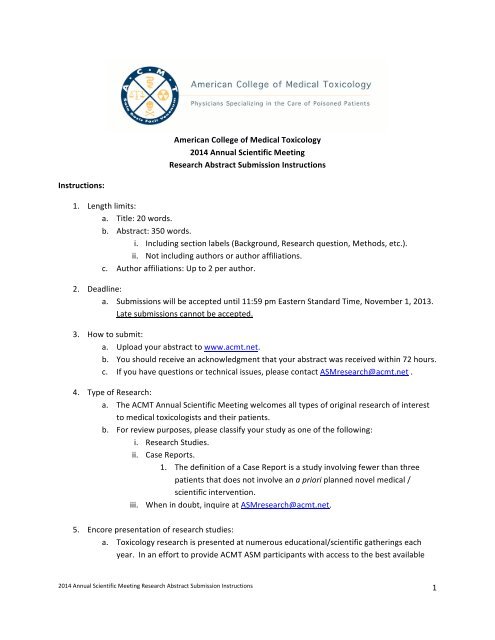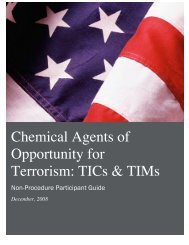Research Abstract Submission Instructions with Examples
Research Abstract Submission Instructions with Examples
Research Abstract Submission Instructions with Examples
Create successful ePaper yourself
Turn your PDF publications into a flip-book with our unique Google optimized e-Paper software.
e. Fonts and symbols: i. Please use Arial, 11 point, single spaced. ii. Do not change the margins from the original template. iii. Please use only symbols from common Microsoft or Apple system fonts. iv. Do not use colors, bold font, or shading. v. Use italics to designate scientific names or foreign words (e.g. Crotalus, a priori). Do not use italics or underlining for emphasis. vi. Do not capitalize each word or all words of the abstract title f. Proprietary names: Do not use proprietary (trade) names of any product unless necessary to convey specific information. Use standard/recognized generic names. g. References: Do not include references in your abstract. It is appropriate to provide references in an eventual poster or platform presentation. 8. Authors: a. All submissions must conform to the Internal Committee of Medical Journal Editors Authorship and Contributorship requirements, available here: http://www.icmje.org/ethical_1author.html. b. Author names should be listed as last name and initials, separated by commas (e.g. Rumack BH, Goldfrank LR) c. There is no limit to the number of authors d. A maximum of 2 affiliations per author are permitted. i. Include: Institution, City, US State or Country (e.g. University of Sorghum, Smallville, NE) ii. Do not include department or division. 9. Funding support: a. All funding support must be disclosed. 10. Selection process and criteria: a. All eligible abstracts will be stripped of identifying information and undergo blinded peer review by at least three members of the ACMT research committee i. Reviewers will be required to disclose conflicts of interest and recuse themselves from review of any abstract involving a personal, professional, or financial conflict. ii. Scoring will be based on the following components: 1. The CLINICAL QUESTION is interesting and relevant to medical toxicologists. 2. The DATA SOURCE is appropriate for the clinical question. 3. The ANALYTIC METHOD is appropriate for the clinical question and data source. 4. The RESULTS and CONCLUSIONS appear to be valid and useful to medical toxicologists. 5. The PRESENTATION OF THE ABSTRACT is clear and complete. 2014 Annual Scientific Meeting <strong>Research</strong> <strong>Abstract</strong> <strong>Submission</strong> <strong>Instructions</strong> 4
. Selection will be based on overall score. c. All authors will receive a decision about acceptance by mid-‐December. 11. Platform and poster presentations a. All accepted abstracts will be presented in poster form at the meeting i. At least one listed author is required to register for the meeting and participate in the authors <strong>with</strong> posters session. 1. If problems come up, please contact ASMresearch@acmt.net to resolve them as soon as possible. b. In addition, the <strong>Research</strong> Studies <strong>with</strong> the top overall scores will be accepted for platform presentation. i. Encore presentations are be eligible for platform presentation, <strong>with</strong> the limitation that research that has been presented as a platform at a previous meeting geared primarily toward medical toxicologists will generally not be eligible for platform presentation at ACMT ASM. 12. Awards: a. The <strong>Research</strong> Committee will recognize awards (e.g. Best Platform Presentation, Best <strong>Research</strong> Presentation by a Physician-‐in-‐Training), based on presentations given at ACMT ASM. Thank you for choosing to submit your work to the 2014 ACMT Annual Scientific Meeting! 2014 Annual Scientific Meeting <strong>Research</strong> <strong>Abstract</strong> <strong>Submission</strong> <strong>Instructions</strong> 5
American College of Medical Toxicology 2014 Annual Scientific Meeting EXAMPLE 1 (<strong>Research</strong> Study) Page 1 of 2 Title Corresponding author name Email address for all correspondence Type of <strong>Research</strong> (<strong>Research</strong> Study or Case Report) First Author (e.g. Rumack BH) First Author affiliations (e.g. University of Maine, Portland, ME) Second Author Second Author affiliations Third Author Third Author affiliations Fourth Author Fourth Author affiliations Fifth Author Fifth Author affiliations Sixth Author Sixth Author affiliations Are there more than six authors?(If so, write “yes” and attach a complete author list) Word Count (abstract only) Has this work been previously presented? List all previous presentations of this work, including abstracts Will this work be published in manuscript form before March 17, 2013? (Yes or No) List all funding sources for this work What IRB/IACUC approved this study (If Exempt, write “Exempt”) “I certify that this work conforms to the ICMJE Authorship and Contributorship requirements” Does Acetaminophen Poisoning Increase Risk of Allergy to Cats? Bruce Lee karateguy@hongkong.net <strong>Research</strong> Study Lee BJ University of San Francisco, San Francisco, CA Davidson H University of Northern South Dakota, Sturgiss, SD n/a No 245 Yes Platform presentation at ASPCA Annual Scientific Meeting, Catalina Island, CA, December 12, 2013; abstract published in ASPCA Journal, November 2013 No Internally funded UCSF IACUC approved Yes
American College of Medical Toxicology 2014 Annual Scientific Meeting EXAMPLE 2 (Case Report) Title Corresponding author name Email address for all correspondence Type of <strong>Research</strong> (<strong>Research</strong> Study or Case Report) First Author (e.g. Rumack BH) First Author affiliations (e.g. University of Maine, Portland, ME) Second Author Second Author affiliations Third Author Third Author affiliations Fourth Author Fourth Author affiliations Fifth Author Fifth Author affiliations Sixth Author Sixth Author affiliations Are there more than six authors?(If so, write “yes” and attach a complete author list) Word Count (abstract only) Has this work been previously presented? List all previous presentations of this work, including abstracts Will this work be published in manuscript form before March 17, 2013? (Yes or No) List all funding sources for this work What IRB/IACUC approved this study (If Exempt, write “Exempt”) “I certify that this work conforms to the ICMJE Authorship and Contributorship requirements” Page 1 of 2 Neutoprolol Extraction During High-‐Flux Hemodialysis Bruce Wayne imbatman@gotham.edu Case report Wayne B Gotham Technical University, Gotham City, NY Grayson R Gotham Technical University, Gotham City, NY Pennyworth A University of the Virgin Islands, Charlotte Amilie, USVI n/a No 271 Yes None No None Exempt Yes
American College of Medical Toxicology 2014 Annual Scientific Meeting EXAMPLE 3 (Case Report) Page 1 of 2 Title <strong>Abstract</strong> text Laszlomonium Ingestion <strong>with</strong> Serum LevelsBackground: Laszlomonium is a novel therapy <strong>with</strong> FDA indications to preventhydrophobia. There is no experience <strong>with</strong> overdose of this drug. Hypothesis: Wehypothesize that symptoms following acute overdose should correlate <strong>with</strong> serumlevels. Methods: This is a single patient chart review. A 76 year old male <strong>with</strong> ahistory of dementia and diabetes accidentally ingested 5,000 mg of his son’slaszlomonium. Within two hours, he developed repeated episodes of vomiting,myoclonic jerking, and then coma. Naloxone and flumazenil were administered<strong>with</strong>out effect. The patient was intubated and mechanically ventilated. The comapersisted for 48 hours at which point he rapidly awoke. Serum was obtainedevery 12 hr and laszlomonium levels were determined via GC-massspectroscopy using methylated-laszlomonium as a standard. Results: Levelsappear in the table. Discussion: This case of acute ingestion presented <strong>with</strong>unexpected findings of myoclonus and prolonged coma. Laszlomonium isreportedly metabolized via mixed hepatic oxidase enzymes, has a therapeuticserum range of 10-15 mg/L, and has a elimination T1/2 of 6 hr. The pattern ofserum levels suggests enzyme saturation. Levels correlated <strong>with</strong> duration ofcoma. Conclusion: Coma may occur following laszlomonium ingestion and druglevels correlated <strong>with</strong> duration of symptoms.Table: Laszlomonium Levels vs. Time Post-‐Ingestion (PI) Time PI 6 hr 12 hr 24 hr 36 hr 48 hr 60 hr 72 hr Level mg/L 28.7 32.0 29.4 30.5 16.0 8.0 undetectable
















